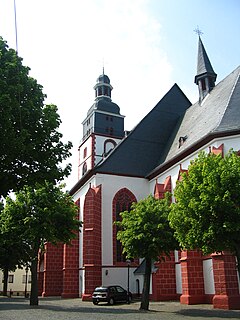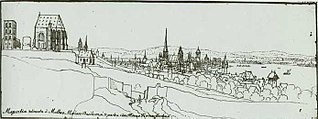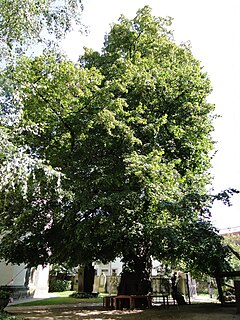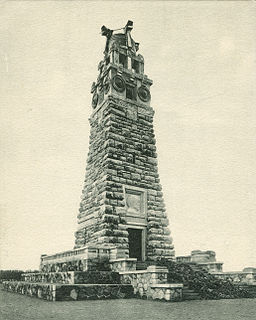History and architecture
The idea of building such a tower in Viersen was born on the occasion of a birthday party in 1899 in honour of Kaiser William by especially influential and patriotic Viersen citizens. The necessary money was to be collected by fund-raising activities to which the mayor, Peter Stern, not only contributed, but was one of the driving forces of the action group. In the end 104 citizens donated about 36,000 Marks (ℳ). The project was not without opponents: the Viersen pastor, Lorenz Richen, in the name of all Roman Catholic priests gave a passionate speech against the idea of honouring Bismarck of all people. Bismarck, who in his time had fiercely fought against Roman Catholic influence, for instance in the school system, was for years unpopular in the mostly Catholic Rhineland. Due to this speech encouraging Roman Catholics to protest, Richen lost his job as school inspector.
The idea for such a project did not, however, originate in Viersen. As early as 1899 the patriotic "Deutsche Studentenschaften" (German Students Association) decided to honour Bismarck as the founder of the German Empire in 1871. [1] After a competition for the design of towers or columns they received 317 architectural plans and finally awarded the prize to the design by the Dresden architect Wilhelm Kreis called "Götterdämmerung". His work inspired many tower projects all over Germany. In Viersen that plan was realized in 1900 in a just a bit slimmer version, than the original "Götterdämmerung". It ended in a huge iron brazier on top of the building in order to light a beacon visible for miles on special occasions. The selected construction material became cuboid greywacke from the Wiehl Valley. [2]
The laying of the foundation stone was witnessed by several thousand people [3] although the protesters had asked the Roman Catholic majority in town not to hoist the flags along the way of the patriotic procession leading from the town to the building site. The tower, then usually called the "Bismarck Column", was finished already in 1901. [4]
It has a total height of 18.22 metres. On the night of the inaugural celebration the beacon was lit for the first time, and up to the time of World War I every year on the occasion of Bismarck's birthday, 1 April, for about two hours. The flames reached a height of about 4–5 metres. In the base, built from three ever smaller growing pedestals, there are 12 steps leading up to an iron door. Four columns with a diameter of 1.80 metres rise from the corners of the plinth with three quarters of their perimeter visible on the outside. Above that rises, with an out jutting cornice the architrave. As decoration for the iron door on the western side the Düsseldorf architect Josef Kleesattel designed a coloured coat of arms of the Bismarck family as well as their motto "In trinitate robur" (in trinity, there is power) and the Berlin sculptor Arnold Künne created a bronze relief of the chancellor for the eastern front of tower. Within a steep flight of stairs with 60 steps leeds up to the viewing platform. [5]
At the end of the 1970s the building was closed, based on safety reasons. The restoration of the structural condition became unavoidable. For financial reasons it was not effected until 2001 within the framework of the "Euroga". The city of Viersen, the municipal savings bank and funding by the county together were able to raise the necessary €370.000 . Among other things the crumbling cement mortar lining of the joints was changed to a more modern material to avoid efflorescence. [6]

Friedrich Albert Lange was a German philosopher and sociologist.

The Grunewald Tower or Grunewaldturm (help·info) is a historical tower in the Grunewald forest of southwestern Berlin, Germany, built in 1897-99 according to plans designed by Franz Heinrich Schwechten. The viewing platform offers a view over the Havel at a height of 36 metres (118 ft).

The Burchardi flood was a storm tide that struck the North Sea coast of North Frisia and Dithmarschen on the night between 11 and 12 October 1634. Overrunning dikes, it shattered the coastline and caused thousands of deaths and catastrophic material damage. Much of the island of Strand washed away, forming the islands Nordstrand, Pellworm and several halligen.

Ichenhausen is a town in the district of Günzburg, in Bavaria, Germany. It is situated on the river Günz, 9 km south of Günzburg.

Kirchberg, the Stadt auf dem Berg, called Kerbrich in Moselle Franconian, is a town in the Rhein-Hunsrück-Kreis (district) in Rhineland-Palatinate, Germany. It is the seat of the like-named Verbandsgemeinde, to which it also belongs.

St. Alban's Abbey, Mainz originated as a Benedictine abbey, founded in 787 or 796 by Archbishop Richulf (787–813) in honour of Saint Alban of Mainz, located to the south of Mainz on the hill later called the Albansberg. It was turned into a collegiate foundation (Herrenstift) in 1442. The buildings were entirely destroyed in 1552, although the foundation retained a legal existence until its formal dissolution in 1802.
Süchteln is a borough (Stadtbezirk) of Viersen, a town which is the centre of the Kreis of Viersen in North Rhine-Westphalia, Germany.
Gustav Abb was a German Nazi librarian.

The Heiligenberg is a large wooded hill overlooking the town of Heidelberg in Baden-Württemberg, Germany. It rises to around 440 metres NHN. It has been the site of many historic and pre-historic constructions, including a Celtic hilltop fortification, a Roman sacred precinct, several medieval monasteries, modern lookout towers and the Heidelberg Thingstätte, built by the Nazis in the 1930s.

Collmberg, regionally and colloquially called Collm, is the highest elevation in the Nordsachsen district and of the Northwest Saxon Basin, situated 6 km west of Oschatz near the small village of Collm. Until the 19th Century it was also called Spielberg and has also been known as Oschatzer Collm.

From 1868 onwards, Bismarck monuments were erected in many parts of the German Empire in honour of the long-serving Prussian minister-president and first German Reichskanzler, Prince Otto von Bismarck. Today some of these monuments are on the soil of other countries including France, Poland and Russia as well as the former German colonies on other continents.

The Brunswick Lion is a medieval sculpture, created in bronze between 1164 and 1176, and the best-known landmark in the German city of Brunswick. The Brunswick Lion was originally located on the Burgplatz square in front of the Brunswick Cathedral. The monument was moved to Dankwarderode Castle in 1980, and later replaced at the original location by a replica. Within Brunswick, it is commonly known as the "Castle Lion" (Burglöwe).
Jakob Herman Schell was a German philosopher and theologian. He was ordained as a Roman Catholic priest in 1873, he became Professor of theology in 1888.

The lime tree of Kaditz is a natural landmark situated in the churchyard of Emmaus Church in Kaditz, a district of Dresden in Saxony, Germany. The large-leaved lime tree is 20 metres (66 ft) high and is estimated to be between 500 and 1,000 years old. The girth of the trunk is about 10 metres (33 ft). In 1818 the tree was badly damaged by a huge fire in the village, which caused the trunk to split in two. It developed an abnormal growth to compensate for the damage done by the fire. This lime tree has often been written about and depicted, especially in Germany, and has also been used as a case study in dendrology, the science of trees and wooded plants. With its large girth it was ranked among the biggest lime trees in Germany even in the 19th century. The Kaditz Lime is also said to have served as a kind of pillory in the Middle Ages. The German Tree Archive includes it in its list of the most significant trees in the nation, in which the most important criterion is the girth of the trunk measured at a height of 1 metre.

The Bismarck Tower in Hanover, Germany was a tower erected as a monument to the first Chancellor of the united German nation Otto von Bismarck for patriotic and nationalistic purposes, which then became a hub for national socialist events in the city until its dismantlement in 1935 as part of the building of the Maschsee.

The Royal Palace of Werla is located near Werlaburgdorf in Lower Saxony. The grounds of the royal palace cover about 20 hectares rising atop Kreuzberg hill, a 17 m high natural plateau overlooking the Oker river. In the Early Middle Ages the palace was an important place in the Holy Roman Empire, serving as an important base for the Ottonians in the 10th century in particular. Although it subsequently lost its political significance to the newly established Imperial Palace of Goslar at Rammelsberg, it developed into an independent settlement with a busy industrial quarter. In the 14th century it fell into ruin and was completely unknown until its rediscovery in the 18th century. The core fortress in particular was thoroughly excavated in the 20th century. Excavations carried out since 2007 have brought new understanding to the hitherto largely unexplored outworks. Since 2010 the palace complex with foundation and enceinte, as well as earthworks, has been partially reconstructed and is now open to the public as the Archäologie- und Landschaftspark Kaiserpfalz Werla.

Wildenburg Castle is a ruined castle near Kempfeld in the county of Birkenfeld in the German state of Rhineland-Palatinate.
Friedrich Wilhelm Karl, Ritter von Hegel was a German historian and son of the philosopher Georg Wilhelm Friedrich Hegel. During his lifetime he was a well-known and well-reputed historian who received many awards and honours, because he was one of the major urban historians during the second half of the 19th century.

Karl Pabst (1835–1910) was a German municipal politician and Lord Mayor of the city of Weimar.

Eduard Adolf Daelen was a German painter and writer. For some of his writings he used the pseudonyms Ursus teutonicus, Angelo Dämon, Edu Daelen-Bachem and Michel Bär. He became known above all for the first biography of Wilhelm Busch, which he wrote in 1886.

















